SOCR EduMaterials Activities ExpCarTimeExperiment
From Socr
m |
(→Exponential data sampling) |
||
| Line 31: | Line 31: | ||
=== Exponential data sampling=== | === Exponential data sampling=== | ||
| - | We can use this applet to geenrate a sample of an arbitrally size from an Exponential Distribution with specified rate parameter. Then these data may be used for simulations or exploratory data analsys. For example, suppose we ran the experiment with k=1,000, as shown onthe image above. We can copy the sample from the '''Y''' column and past it in any of the [http://socr.ucla.edu/htmls/SOCR_Charts.html SOCR Charts]. The image below shows the construction of a ''Statistical Bar Chart'' using the 1,000 Exponential (between-car) time measurements. Notice how the sumamry statistics on this Bar Chart coinside with the data-statistics reported on the distribution table of the Exponential Time Car Experiment applet. | + | We can use this applet to geenrate a sample of an arbitrally size from an Exponential Distribution with specified rate parameter. Then these data may be used for simulations or exploratory data analsys. For example, suppose we ran the experiment with k=1,000, as shown onthe image above. We can copy the sample from the '''Y''' column and past it in any of the [http://socr.ucla.edu/htmls/SOCR_Charts.html SOCR Charts]. The image below shows the construction of a ''Statistical Bar Chart'' using the 1,000 Exponential (between-car) time measurements. Notice how the sumamry statistics on this Bar Chart coinside with the data-statistics reported on the distribution table of the Exponential Time Car Experiment applet. The last graph (bottom-right) illustrates a (Q-Q) plot of the Normal vs. Exponential-sample quantiles. The highly non-linear shape of this QQ plot indicates the significant departure of normality of these Exponential time measurements (between-car times). |
<center>[[Image:SOCR_Activities_ExpCarTimeExperiment_Dinov_011908_Fig3.jpg|400px]] | <center>[[Image:SOCR_Activities_ExpCarTimeExperiment_Dinov_011908_Fig3.jpg|400px]] | ||
[[Image:SOCR_Activities_ExpCarTimeExperiment_Dinov_011908_Fig5.jpg|400px]]</center> | [[Image:SOCR_Activities_ExpCarTimeExperiment_Dinov_011908_Fig5.jpg|400px]]</center> | ||
| - | <center>[[Image:SOCR_Activities_ExpCarTimeExperiment_Dinov_011908_Fig6.jpg|400px]]</center> | + | <center>[[Image:SOCR_Activities_ExpCarTimeExperiment_Dinov_011908_Fig6.jpg|400px]] |
| + | [[Image:SOCR_Activities_ExpCarTimeExperiment_Dinov_011908_Fig7.jpg|400px]]</center> | ||
===Exponential model-fitting and assessment=== | ===Exponential model-fitting and assessment=== | ||
Revision as of 00:10, 20 January 2008
Contents |
Exponential Time Car Activity
Description
TBD.
Goal
To provide an interactive simulation demonstrating exponential processes, exponential decay, simulation and model fitting. Additional aims are to:
- Draw analogy between Gamma, Exponential and Poisson (discrete!)
- Provide the means for (large) data generation/sampling
- Provide the infrastructure for model-fitting and assessment.
Experiment
Go to the SOCR Experiments and select the Exponential Car-Time Experiment from the drop-down list of experiments on the top left. The image below shows the initial view of this experiment with pointers and highlights of the most important components and controls:
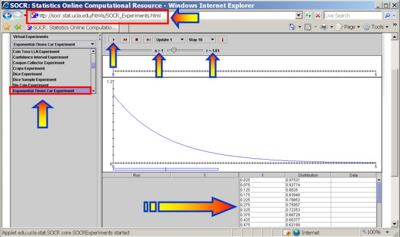
Select the number of cars (k) and the rate of the exponential process (r). When pressing the play button, one trial will be executed that involves sampling k random exponential time variables (representing the between car times). The results will be displayed graphically in the two graph windows (timeline and histogram) for this process. Summary statistics and model vs. data distributions are shown in the distribution table below. The stop button ceases any activity and is helpful when the experimenter chooses a large number of cars (k is large). The reset button will clear and re-initialize the entire experiment, deleting all previous information and data collected.
As the number of cars (k) increases, the distribution of the between-car times will have exponential-decay shape. Note that as the number of cars (k) increases, the empirical histogram (graph) and moments (table) of the random exponential times begin to converge to their corresponding Exponential distribution counterparts. Arrows point to the match of the empirical histogram of the between-car times and theoretical Exponential distribution, the random sample of between-car times (Y column of left table) and the similarity between the first two moments of the sample data and model (Exponential) distributions.
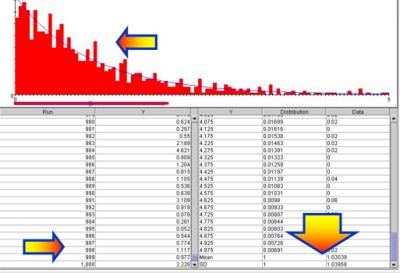
Applications
Analogy between Gamma, Exponential and Poisson distributions
Number of Arrivals in a fixed time-period follows Poisson distribution.
Exponential data sampling
We can use this applet to geenrate a sample of an arbitrally size from an Exponential Distribution with specified rate parameter. Then these data may be used for simulations or exploratory data analsys. For example, suppose we ran the experiment with k=1,000, as shown onthe image above. We can copy the sample from the Y column and past it in any of the SOCR Charts. The image below shows the construction of a Statistical Bar Chart using the 1,000 Exponential (between-car) time measurements. Notice how the sumamry statistics on this Bar Chart coinside with the data-statistics reported on the distribution table of the Exponential Time Car Experiment applet. The last graph (bottom-right) illustrates a (Q-Q) plot of the Normal vs. Exponential-sample quantiles. The highly non-linear shape of this QQ plot indicates the significant departure of normality of these Exponential time measurements (between-car times).
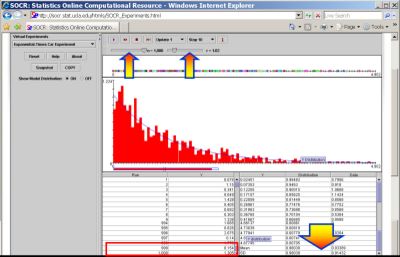
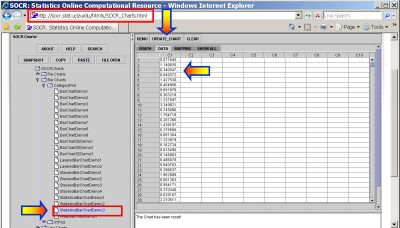
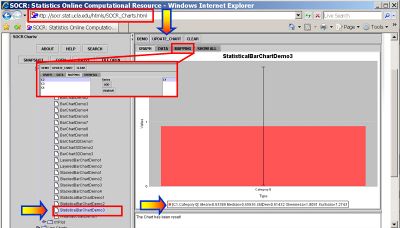
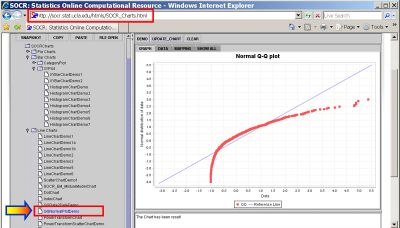
Exponential model-fitting and assessment
Translate this page:
